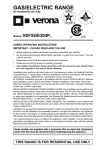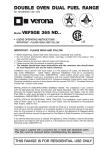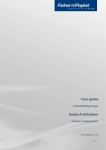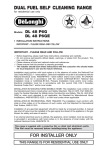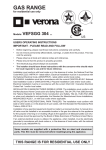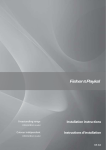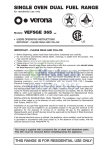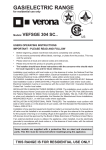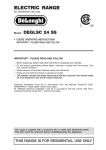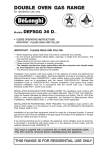Download De'Longhi P6E User's Manual
Transcript
DUAL FUEL SELF CLEANING RANGE for residential use only Model DL 48 P6E • USERS OPERATING INSTRUCTIONS IMPORTANT - PLEASE READ AND FOLLOW IMPORTANT - PLEASE READ AND FOLLOW ✓ Before beginning, please read these instructions completely and carefully. ✓ Do not remove permanently affixed labels, warnings, or plates from the product. This may void the warranty. ✓ Please observe all local and national codes and ordinances. ✓ Please ensure that this product is properly grounded. ✓ The installer should leave these instructions with the consumer who should retain for local inspector's use and for future reference. Installation must conform with local codes or in the absence of codes, the National Fuel Gas Code ANSIZ223.1 - Iatest edition. Electrical installation must be in accordance with the National Electrical Code, ANSI/NFPA70 - latest edition and/or local codes. IN CANADA: Installation must be in accordance with the current CAN/CGA-B149.1 National Gas Installation Code or CAN/CGA-B149.2, Propane Installation Code and/or local codes. Electrical installation must be in accordance with the current CSA C22.1 Canadian Electrical Codes Part 1 and/or local codes. INSTALLATION IN MANUFACTURED (MOBILE) HOME: The installation must conform with the Manufactured Home Construction and Safety Standard, Title 24 CFR, Part 3280 [formerly the Federal Standard for Mobile Home Construction and Safety, Title 24, HUD (Part 280)] or, when such standard is not applicable, the Standard for Manufactured Home Installations, ANSI/NCSBCS A225.1, or with local codes where applicable. INSTALLATION IN RECREATIONAL PARK TRAILERS: The installation must conform with state or other codes or, in the absence of such codes, with the Standard for Recreational Park Trailers, ANSI A119.5. Installation of any gas-fired equipment should be made by a Iicensed plumber. A manual gas shut-off valve must be installed in the gas supply line ahead of the appliance in the gas stream for safety and ease of service. If an external electrical source is utilized, the appliance, when installed, must be electrically grounded in accordance with local codes or, in the absence of local codes, with the national Electrical Code, ANSI/NFPA 70. This range is supplied with a protective film on steel and aluminium parts. This film must be removed before installing/using the appliance. THIS RANGE IS FOR RESIDENTIAL USE ONLY WARNING • ALL RANGES CAN TIP • INJURY TO PERSON COULD RESULT • INSTALL ANTI-TIP DEVICE PACKED WITH RANGE • SEE INSTALLATION INSTRUCTIONS WARNING: IF THE INFORMATION IN THIS MANUAL IS NOT FOLLOWED EXACTLY, A FIRE OR EXPLOSION MAY RESULT CAUSING PROPERTY DAMAGE, PERSONAL INJURY, OR DEATH. ✓ Do not store or use gasoline or other flammable vapors and liquids in the vicinity of this or any other appliance. ✓ WHAT TO DO IF YOU SMELL GAS: • Do not try to light any appliance. • Do not touch any electrical switch; do not use any phone in your building. • lmmediately call your gas supplier from a neighbor's phone. Follow the gas supplier's instructions. • lf you cannot reach your gas supplier, call the fire department. ✓ Installation and service must be performed by a qualified installer, service agency, or the gas supplier. 2 Dear Customer, Thank you for having purchased and given your preference to our product. The safety precautions and recommendations reported below are for your own safety and that of others. They will also provide a means by which to make full use of the features offered by your appliance. Please preserve this booklet carefully. It may be useful in future, either to yourself or to others in the event that doubts should arise relating to its operation. This appliance must be used only for the task it has explicitly been designed for, that is for cooking foodstuffs. Any other form of usage is to be considered as inappropriate and therefore dangerous. The manufacturer declines all responsibility in the event of damage caused by improper, incorrect or illogical use of the appliance. This appliance is designed and manufactured solely for the cooking of domestic (household) food and in not suitable for any none domestic application and therefore should not be used in a commercial environmement. The appliance guarantee will be void if the appliance is used within a none domestic environnement i.e. a semi commercial, commercial or communal environment. 3 USER INSTRUCTIONS GENERAL INFORMATION WARNING!! 1. This appliance shall not be used for space heating. This information is based on safety considerations. ELECTRICAL GROUNDING INSTRUCTIONS 2. AlI openings in the wall behind the appliance and in the floor under the appliance shall be sealed. The range must be electrically grounded in accordance with local codes or, in the absence of local codes, with the National Electrical Code, ANSI/NFPA No. 70-latest edition. Installation should be made by a Iicensed electrician. 3. Keep appliance area clear and free from combustible materials, gasoline, and other flammable vapors. FOR PERSONAL SAFETY, THIS APPLIANCE MUST BE PROPERLY GROUNDED. 4. Do not obstruct the flow of combustion and ventilation air. If an external electrical source is utilized, the installation must be electrically grounded in accordance with local codes or, in the absence of local codes, with the national Electrical Code, ANSI/NFPA 70. 5. Disconnect the electrical supply to the appliance before servicing. 6. When removing appliance for cleaning and/or service; A. Shut off gas at main supply. B. Disconnect AC power supply. C. Disconnect gas line to the inlet pipe. D. Carefully remove the range by pulling outward. CAUTION: Range is heavy; use care in handling. 7. Electrical Requirement Electrical installation should comply with national and local codes. 8. Air Supply and Ventilation The installer must refers to local/national codes. 9. Gas Manifold Pressure Natural gas - 4.0” W.C.P. LP/Propane - 11.0” W.C.P. 10. The misuse of oven door (e.g. stepping, sitting, or leaning on them) can result in potential hazards and/or injuries. 11. When installing or removing the range for service, a rolling lift jack should be used. Do not push against any of the edges of the range in an attempt to slide it into or out of the installation. Pushing or pulling a range (rather than using a lift jack) also increases the possibility of bending the leg spindles or the internal coupling connectors. 4 WARNING!! REPLACEMENT PARTS Only authorized replacement parts may be used in performing service on the range. Replacement parts are available from factory authorized parts distributors. Contact the nearest parts distributor in your area. IMPORTANT PRECAUTIONS AND RECOMMENDATIONS After having unpacked the appliance, check to ensure that it is not damaged. In case of doubt, do not use it and consult your supplier or a professionally qualified technician. Packing elements (i.e. plastic bags, polystyrene foam, nails, packing straps, etc.) should not be left around within easy reach of children, as these may cause serious injuries. . The packaging material is recyclable and is marked with the recycling symbol ✓ Do not attempt to modify the technical characteristics of the appliance as this may become dangerous to use. ✓ Do not carry out cleaning or maintenance operations on the appliance without having previously disconnected it from the electric power supply. ✓ After use, ensure that the knobs are in OFF position. ✓ Do not allow children or other incapable people to use the appliance without supervision. ✓ During and after use of the range, certain parts will become very hot. Do not touch hot parts. ✓ Keep children away from the range when it is in use. ✓ This range is supplied with a protective film on steel and aluminium parts. This film must be removed before installing/using the appliance. ✓ Fire risk! Do not store flammable material in the ovens, and in the warming drawers. ✓ Make sure that electrical cables connecting other appliances in the proximity of the range cannot come into contact with the hob or become entrapped in the oven doors. ✓ Do not line the oven walls with aluminium foil. Do not place shelves, grill-pan, pans or other cooking utensils on the base of the oven chamber. ✓ The manufacturer declines all liability for injury to persons or damage to property caused by incorrect or improper use of the appliance. ✓ To avoid any possible hazard, the appliance must be installed by qualified personnel only. Any repairs by unqualified persons may result in electric shock or short circuit. In order to avoid possible injuries to your body or to the appliance, do not attempt any repairs by yourself. Such work should be carried out by qualified service personnel only. ✓ Danger of burns! The oven and cooking accessories may become very hot during operation. Make sure children are kept out of reach and warn them accordingly. To avoid burns use kitchen clothes and gloves when handling hot parts or utensils. ✓ Stand away from the range when opening oven door. Hot air or steam which escapes can cause burns to hands, face, and/or eyes. ✓ Never clean the range, ovens and warmer drawers with a high-pressure steam cleaning device, as it may provoke a short circuit. ✓ This appliance is intended for use in your household. Never use the appliance for any other purpose! ✓ If you should decide not to use this appliance any longer (or decide to substitute an older model), before disposing of it, it is recommended that it be made inoperative in an appropriate manner in accordance to health and environmental protection regulations, ensuring in particular that all potentially hazardous parts be made harmless, especially in relation to children who could play with old appliances. Remove the doors and drawers before disposal to prevent entrapment. IMPORTANT PRECAUTIONS AND RECOMMENDATIONS FOR USE OF ELECTRICAL APPLIANCES Use of any electrical appliance implies the necessity to follow a series of fundamental rules. In particular: ✓ Never touch the appliance with wet hands or feet; ✓ Do not operate the appliance barefooted; ✓ Do not allow children or disabled people to use the appliance without your supervision. The manufacturer cannot be held responsible for any damages caused by improper, incorrect or unreasonable use of the appliance. 5 features Island trim fitted Backguard fitted WARNING - VERY IMPORTANT NOTICE Never obstruct the slots on the backguard / island trim. 1 1 3 3 2 Fig. 1.1 COOKING HOB 1. Rapid burner (R) - 10000 BTU/hr 2. Triple-ring burner (TR) - 12000 BTU/hr 3. Dual burner (D) - 16000 BTU/hr (Natural gas), 15000 BTU/hr (LP/Propane) Note: - The electric gas-lighting device is incorporated into the knobs. - The appliance has a safety valve system fitted, the flow of gas will be stopped if and when the flame should accidentally go out. CAUTION: If the burner is accidentally extinguished, turn the gas off at the control knob and wait at least 1 minute before attempting to relight. CAUTION: Gas appliances produce heat and humidity in the environment in which they are installed. Ensure that the cooking area is well ventilated following national/local codes. 6 2 9 10 11 18 20 14 15 16 A U T O A U T O 7 8 1 2 3 17 19 4 5 6 13 12 Fig. 1.2 CONTROLS DESCRIPTION Gas cooking hob controls: 1. 2. 3. 4. 5. 6. Front left burner (2) control knob Rear left burner (1) control knob Central left dual burner (3) control knob Central right dual burner (3) control knob Rear right burner (1) control knob Front right burner (2) control knob Left self cleaning oven controls: 7. Function selector control knob 8. Electronic programmer 9. Heating pilot light 10. Oven on pilot light 11. Door locked pilot light Right self cleaning oven controls: 12. Function selector control knob 13. Electronic programmer 14. Heating pilot light 15. Oven on pilot light 16. Door locked pilot light Left warming drawer controls: 17. Warming drawer control knob 18. Warming drawer on pilot light Right warming drawer controls: 19. Warming drawer control knob 20. Warming drawer on pilot light 7 how to use the top burners GAS BURNERS (Rapid and triple ring) Gas flow to the burners is adjusted by turning the knobs (illustrated in fig. 2.1) which control the valves. Turning the knob so that the symbols printed on itself point to the symbol printed on the control panel achieves the following functions: Knob position Function RAPID burner TRIPLE RING burner closed valve maximum rate Fig. 2.1 minimum rate The maximum aperture position permits rapid boiling of liquids, whereas the minimum aperture position allows simmer warming of food or maintaining boiling conditions of liquids. To reduce the gas flow to minimum, rotate the knob further anti-clockwise to point the indicator towards the position. Other intermediate operating adjustments can be achieved by positioning the indicator between the maximum and minimum aperture positions, and never between the maximum aperture and positions. Fig. 2.2 N.B. When the range is not being used, set the gas knobs to their positions and also close the gas shut-off valve placed on the main gas supply line. 8 LIGHTING GAS BURNERS FITTED WITH FLAME FAILURE SAFETY DEVICE (Rapid and triple ring) In order to light the burner, you must: 1 – Push and turn the knob in an anti-clockwise direction up to the position (maximum rate), push in and hold the knob until the flame has been lit (fig. 2.2). The sparks produced by the lighter situated inside the relative burner will light the flame. In the event that the local gas supply conditions makes it difficult to light the burner in position, try again with the knob in position. If there is no mains electrical supply, bring a lighted match close to the burner. 2 – Wait for about ten seconds after the gas burner has been lit before letting go the knob (safety device activation delay). 3 – Adjust the gas valve to the desired position. If the burner flame should go out for some reason, the safety valve will automatically stop the gas flow. To re-light the burner, return the knob to the closed minute and then repeat the lighting procedure. position, wait for at least 1 If your local gas supply makes it difficult to light the burner with the knob set to maximum, set the knob to minimum and repeat the operation. Caution! The range becomes very hot during operation. Keep children well out of reach. 9 GAS BURNERS (Dual) The Dual Burner is a very flexible burner which allows different regulations and optimal cooking. It is composed by one inner and two outer crowns; the flame of the inner crown can be regulated separately from the flames of the outer crowns. The Dual Burner can be used: - as a small burner (flame produced only by the inner crown) which can be adjusted from the maximum ( ) to the minimum ( ) position. Intermediate operating adjustments can be achieved by positioning the indicator between the maximum and minimum opening positions, and never between the maximum opening and position. - as a high-power burner (all flames produced simultaneously by inner and outer crowns) which can be adjusted from the maximum ( ) to the minimum ( ) position. Gas flow to the burners is adjusted by turning the knobs (illustrated in fig. 2.3) which control the valves. Turning the knob so that the symbols printed on itself point to the symbol printed on the control panel achieves the following functions: Knob position Function closed valve Fig. 2.3 maximum rate of inner crown (only inner flame at the maximum) minimum rate of inner crown (only inner flame at the minimum) Fig. 2.4 maximum rate of inner + outer crowns (inside and outside flames in simultaneously at the maximum) minimum rate of inner + outer crowns (inside and outside flames in simultaneously at the minimum) 10 DUAL burner LIGHTING GAS BURNERS FITTED WITH FLAME FAILURE SAFETY DEVICE (Dual Burners) In order to light the burner, you must: 1 – Push and turn the knob in an anti-clockwise direction up to the position (maximum rate of inner crown); push in and hold the knob until the flame has been lit. The sparks produced by the lighter situated inside the relative burner will light the flame. In the event that the local gas supply conditions makes it difficult to light the burner in position, try again with the knob in position. If there is no mains electrical supply connection, bring a lighted match close to the burner. 2 – Wait for about ten seconds after the gas burner has been lit before letting go the knob (safety device activation delay). 2 – Adjust the gas valve to the desired position. If the burner flame should go out for some reason, the safety valve will automatically stop the gas flow. To re-light the burner, return the knob to the closed position ( minute and then repeat the lighting procedure. ), wait for at least 1 N.B. When the range is not being used, set the gas knobs to their positions and also close the gas shut-off valve placed on the main gas supply line. CAUTION! The range becomes very hot during operation. Keep children well out of reach. 11 CHOICE OF BURNER (fig. 2.5) The symbols printed on the panel above the gas knobs indicate the correspondence between the knob and the burner. The most suitable burner is to be chosen according to the diameter and volume capacity of the container to be warmed. It is important that the diameter of the pots or pans suitably match the heating potential of the burners in order not to jeopardise the efficiency of the burners, bringing about a waste of gas fuel. A small diameter pot or pan placed on a large burner does not necessarily mean that boiling conditions are reached quicker. Fig. 2.5 DIAMETERS OF PANS WHICH MAY BE USED ON THE HOB BURNERS BURNER MINIMUM MAXIMUM Rapid 24 cm (9" 7/16) 26 cm (10" 3/16) Triple-ring 26 cm (10" 3/16) 28 cm (11" 1/16) Dual 26 cm (10" 3/16) 28 cm (11" 1/16) Wok pans max 36 cm (14" 3/16) Do not use pans with concave or convex bases WRONG CORRECT USE OF DUAL BURNERS (Fig. 2.6a - 2.6b) The flat-bottomed pans are to be placed directly onto the pan-support. When using a WOK you need to place the supplied stand in the burner to avoid any faulty operation of the dual burner (Figs. 2.6a - 2.6b). Fig. 2.6a IMPORTANT: The special grille for wok pans (fig. 2.6b) MUST BE PLACED ONLY over the pan-rest for the dual burner. CORRECT Fig. 2.6b Make sure that the handles of cookware do not stick out over the edge of the range, to avoid them being knocked over by accident. This also makes it more difficult for children to reach the cooking vessels. 12 how to use the warmer drawer GENERAL FEATURES The warming drawer is fitted with an heating element (500 W) placed on the top. The heating can be regulated from 86 °F (30 °C) [ position]. position] to 248 °F (120 °C) [ On the top part of the drawer a moisture selector is fitted. For correct use see the “MOISTURE SELECTOR” chapter. USING THE WARMING DRAWER FOR THE FIRST TIME • Switch on the warming drawer empty at maximum power (HI) for about 2 hours to remove traces of grease and smells from the components. • When the warming drawer has cooled down and unplugging the range, clean the inside of the drawer with a cloth soaked in water and neutral detergent and dry it perfectly. WARNING: The drawer is hot during operation, use the handle. Fig. 3.1 TO USE THE WARMING DRAWER • Push and turn the control knob to a temperature setting: LO, HI or between LO and HI position. • Slide the Moisture selector to a Moist or Dry position. Intermediate positions can be setted (fig. 3.2) (see the “MOISTURE SELECTOR” chapter). WARNING: The warming drawer is for keeping hot food hot. Never use it to warm or heat a room or to warming plates. • Allow time for the drawer to be preheated. • Preheat with rack in place if using that arrangement. • Preheat empty serving dish while preheating drawer. • Add cooked, hot food in cooking utensil or to heat-safe serving dishes. • Food may be kept hot in its cooking container or transferred to a heat-safe serving dish. • Aluminum foil may be used to cover food. CORRECT USE OF THE WARMING DRAWER • The warming drawer will keep hot cooked foods at serving temperature. • Always start with hot food. • DO NOT use to heat cold food other than proofing yeast dough, crisping crackers, chips, and dry cereal, or warming dishes or plates. • Use care when opening the drawer. Open door a crack and let hot air or steam escape before re-moving or replacing food. • Do not place food in unopened containers in the drawer. Pressure could build up and cause container to burst. • Do not touch the interior surface of the drawer while it is in use. The interior of the drawer could become hot enough to cause burns. CAUTION: Plastic containers or plastic wrap can melt if in direct contact with the drawer or a hot utensil. If it melts onto the drawer, it may not be removable. IMPORTANT: During the self-cleaning cycle the warming drawers do not operate. If during self-cleaning cycle the warming drawer control knob has been turned ON return the knob to the OFF position. Otherwise at the end of the self-cleaning cycle and after having turned the oven selector control knob to the OFF position, the warming drawer will operates. • Use only dry potholders. Moist or damp potholders on hot surfaces may cause burns from steam. Do not use a towel or other bulky cloth in place of potholders. Do not let potholders touch hot heating element located upper the drawer. • Do not use aluminum foil to line the drawer. Foil is an excellent heat insulator and will trap heat beneath it. This will upset the performance of the drawer and it could damage the interior finish. • Do not store flammable materials in the drawer. • Do not use plastic containers. Do not use no heat resistant containers. • Do not use the warming drawer as a storage drawer. 13 Knob position °F °C TEMPERATURE SELECTOR LO 86 30 The setting can be anywhere between LO and HI position. between LO and HI from 87 to 247 from 31 to 119 HI 248 120 WARNING LIGHT The signal light is located above the control knob and turns “ON’ when the warming is set. It stays on until the knob is turned back to the “OFF” position. MOISTURE SELECTOR (fig. 3.2) MOIST DRY Moisture selector MOIST position: Vents closed DRY position: Vents opened To keep foods moist, slide the moisture selector to the left. This closes the vents and the moisture remains inside the drawer. In this setting condensation may occur around the inside edge of the drawer. To keep foods crisp, slide the moisture selector to the right. This opens the vents and allows the moisture to escape. With the vents open, it is normal for moisture to collect on surfaces above the warming drawer. Fig. 3.2 REVERSIBLE RACK The rack shall be positioned as per figures 3.3 and 3.4. 14 Fig. 3.3 Fig. 3.4 Fig. 3.5 Fig. 3.6 how to use the self cleaning ovens GENERAL FEATURES The ovens have special operating features. Five different functions can be used to satisfy all cooking needs; it also has a self cleaning function which can clean the oven cavity at high temperature, a defrost function and an oven light function. These functions are managed by an electronic programmer which keeps the temperature set constant by means of a probe inside the oven cavity. The ovens have the following heating elements: Attention: the oven door becomes very hot during operation. Keep children away. VERY IMPORTANT The oven shall be used always with the door closed. - Lower heating element (double) 500 + 1300 W - Upper heating element 1000 W - Grill heating element 2000 W - Circular heating element 2200 W USING THE OVENS FOR THE FIRST TIME - Put in the shelf and the tray. - Switch the oven on empty (on a cooking function – NOT SELF CLEANING) at maximum power for about 2 hours to remove traces of grease and smells from the components. NEVER USE THE RANGE WHEN ONE OVEN IS OPERATING IN SELF CLEANING MODE. NEVER OPERATE BOTH OVENS OF THE RANGE IN SELF CLEANING MODE AT THE SAME TIME. ALWAYS OPERATE OVENS IN SELF-CLEANING MODE ONE AT A TIME. - When the oven has cooled down and unplugging the range, clean the inside of the oven with a cloth soaked in water and neutral detergent and dry it perfectly. WARNING: The door is hot during operation, use the handle. OPERATING PRINCIPLES Heating and cooking in the multifunction self cleaning oven takes place as follows: • by normal convection The heat is produced by the upper and lower heating elements. • by forced convection The heat produced by the circular element is distributed throughout the oven by the fan. • by radiation The heat is radiated by the infra red broil element. • by radiation and fan The radiated heat from the infra red broil element is distributed throughout the oven by the fan. • by double radiation and fan The fan distributes the heat radiated by the broil heating element and the upper heating element in the oven. • by ventilation The food is defrosted by using the fan only function without heat. • by self cleaning The heat produced by the heating elements cleans the internal oven cavity removing all residue of grease. THIS IS NOT A COOKING FUNCTION WHEN THE SELF CLEANING MODE HAS BEEN COMPLETED: • do not operates immediately the other oven of the range in self cleaning mode: LET THE RANGE TO COOL DOWN. • do not start immediately a new self cleaning cycle on the same oven: LET THE RANGE TO COOL DOWN. IMPORTANT: DURING THE SELF-CLEANING CYCLE THE WARMING DRAWERS DO NOT OPERATE. If during self-cleaning cycle the warming drawer control knob has been turned ON return the knob to the OFF position. Otherwise at the end of the self-cleaning cycle and after having turned the oven selector control knob to the OFF position, the warming drawer will operates. NOTES ON OVEN WORKING I I I I I I I I I I I I I I I I I I I I A cooling fan starts automatically when selecting a cooking or self cleaning mode. It stops when turning the selector knob to OFF or light or defrosting position and the inside oven cavity temperature drops below 100 °C (212 °F). The purpose of this fan is to reduce the temperature inside/outside the appliance. I I I I I I I I I I I I 2 3 Note: The first time the oven is used or after a black-out the programmer must be started by pressing keys 2 and 3 simultaneously. See the chapter “How to use the electronic programmer”. 15 SELECTING THE FUNCTIONS (fig. 4.1) The cooking function is selected by turning the function selector knob and matching the mark with the symbol printed on the print. Important: In all cooking functions the oven must always be used with the DOOR CLOSED. I I I I I I I I I I I I I I I I I I I I If the door stays open “door” appears on the programmer display and after five minutes an audible warning sounds for 30 seconds and “door” flashes. I I I I I I I I I I I I To silence the audible warning press any programmer pushbutton. Fig. 4.1 NOTE: The heating elements work even with the door open and this signal just indicates that energy is being wasted and the control panel/knobs are excessively heated. OVEN LIGHT (this is not a cooking function) On turning the knob to this position only the oven lamp lights up. The lamp is always on in all the cooking functions (not for the self cleaning). DEFROSTING FROZEN FOODS (this is not a cooking function) Only the fan and the oven lamp switch on. Defrosting takes place by fan, without heating. The electronic programmer shows dEF Recommended for: To rapidly defrost frozen foods; 2.2 lbs (1 kg) requires about one hour. The defrosting times vary according to the quantity and type of foods to be defrosted. CONVECTION COOKING WITH VENTILATION The circular element and the fan switch on. The heat from the back is diffused by fan convection. The temperature can be set between 120 °F (50 °C) and 480 °F (250 °C). On selecting this function the electronic programmer starts cooking with a pre-heating temperature set at 320 °F (180 °C). To vary the temperature see the “Setting the cooking” chapter. Recommended for: For foods of large volume and quantity which require the same internal and external degree of cooking; for ex: rolled roasts, turkey, legs, cakes, etc. 16 TRADITIONAL CONVECTION COOKING The upper and lower heating elements switch on. The heat is diffused by natural convection and the temperature must be set between 120 °F (50 °C) and 480 °F (250 °C). On selecting this function the electronic programmer starts cooking with a pre-heating temperature set at 350 °F (200 °C). To vary the temperature see the “Setting the cooking” chapter. Recommended for: For foods which require the same cooking temperature both internally and externally, i. e. roasts, spare ribs, meringue, etc. VENTILATED COOKING WITH DOUBLE BROIL The infrared element, the upper heating element and the fan switch on. The heat is mainly diffused by radiation and the fan distributes it in the whole oven. The temperature can be set between 120 °F (50 °C) and 480 °F (250 °C). On selecting this function the electronic programmer starts cooking with a pre-heating temperature set at 480 °F (240 °C). To vary the temperature see the “SETTING THE COOKING” chapter. For correct use see the “VENTILATED BROILING AND AU GRATIN” chapter. Recommended for: Meats which are to be cooked at a high temperature but which must remain tender. Fish remains more tender; turn it once during cooking. BROILING The infrared heating element switches on. The heat is diffused by radiation. The temperature can be set between 120 °F (50 °C) and 480 °F (250 °C). On selecting this function the electronic programmer starts cooking with a pre-heating temperature set at 480 °F (210 °C). To vary the temperature see the “SETTING THE COOKING” chapter. For correct use see the “BROILING” chapter. Recommended for: Intense broiling action for cooking with the broiler; browning, crisping, “au gratin”, toasting, etc. For correct use see the “GRILLING” chapter. VENTILATED BROILING The infrared heating element and the fan switch on. The heat is mainly diffused by radiation and the fan distributes it in the whole oven. The temperature can be set between 120 °F (50 °C) and 480 °F (250 °C). On selecting this function the electronic programmer starts cooking with a pre-heating temperature set at 480 °F (220 °C). To vary the temperature see the “SETTING THE COOKING” chapter. Recommended for: For grill cooking when a fast outside browning is necessary to keep the juices in, i. e. veal steak, steak, hamburger, etc. For correct use see the “VENTILATED BROILING AND AU GRATIN” chapter. 17 SELF CLEANING FUNCTION (this is not a cooking function) IMPORTANT NOTES: This is not a cooking function but is only used to clean the oven. Before starting the self cleaning cycle: - Take all the accessories out of the oven (drip tray and shelves). - Clean any traces of liquid which have overflowed. - Close the oven door and make sure that it is closed properly. If there are cracks or flaws on the oven door glass (inside/outside) or if the gaskets are ruined or worn or if the door does not close perfectly, unplug the appliance and contact the Service Centre. GENERAL INFORMATION • In this function the residual cooking greases on the inside walls of the oven cavity are pulverised by the high temperature. The fumes produced during this process are filtered by a special catalyst in the upper part of the appliance. • Smells and fumes produced during self cleaning are not a cause of alarm. Adequate ventilation should however be provided in the room where the range is installed, e.g. by opening a window. • Do not wait for the oven to be very greasy before performing this cleaning. It should not be performed after every cooking, either, but only when the level of dirt justifies it (on average 1 – 2 times a month depending on oven use). CAUTION: During the self cleaning cycle the accessible parts may become hot. Keep children away. IMPORTANT: The health of some birds is extremely sensitive to the fumes given off during the self-cleaning cycle. Exposure to the fumes may result in death to certain birds. Always move birds to another closed and well ventilated room. NEVER USE THE RANGE WHEN ONE OVEN IS OPERATING IN SELF CLEANING MODE. NEVER OPERATE BOTH OVENS OF THE RANGE IN SELF CLEANING MODE AT THE SAME TIME. ALWAYS OPERATE OVENS IN SELF-CLEANING MODE ONE AT A TIME. 18 • For safety reasons (high temperature of the oven cavity), when the self cleaning starts the oven door is automatically locked by an electronic device (after about 30 seconds on the control panel the door locked pilot light lights up). The door can no longer be opened and is only unlocked at the end of the cleaning cycle or, stopping the cycle, when the oven cavity has cooled to a temperature lower than 570 °F (300 °C). • When the self cleaning function starts an internal fan starts automatically to cool the oven walls. It only stops at the end of the cycle, when the oven cavity temperature has dropped below 212 °F (100 °C). • The procedures for starting, stopping and completing the self cleaning cycle and dealing with any problems are described in the following chapters: - “How to start the self cleaning cycle” - “Problems on starting and during the self cleaning cycle” - “How to stop the self cleaning cycle” - “What to do when the self cleaning cycle has finished” - “Abnormal situations and/or operating problems” WHEN THE SELF CLEANING MODE HAS BEEN COMPLETED: • do not operates immediately the other oven of the range in self cleaning mode: LET THE RANGE TO COOL DOWN. • do not start immediately a new self cleaning cycle on the same oven: LET THE RANGE TO COOL DOWN. IMPORTANT: DURING THE SELF-CLEANING CYCLE THE WARMING DRAWERS DO NOT OPERATE. If during self-cleaning cycle the warming drawer control knob has been turned ON return the knob to the OFF position. Otherwise at the end of the self-cleaning cycle and after having turned the oven selector control knob to the OFF position, the warming drawer will operates. SELECTING °F/°C ON THE DISPLAY 2. Press key 5 on the programmer to reduce the temperature until you reach the minimum value (120 °F/50 °C). 3. With °F/°C flashing on the display press key 5 again (if °F/°C is not flashing press key 4 before pressing key 5) until OFF appears on the display. 4. Keep key 4 pressed for about 3/5 seconds until the display changes from °C to °F or vice versa. During selection °C or °F is flashing. 5. When OFF apears again on the display turn the selector knob to OFF position; the selection to °C or °F has been completed. ➀ I I I I I I Turn the oven selector knob to a cooking function (i.e. BAKE). I I I I 1. I I I ➁ 5 ➂ 5 ➃ 4 ➄ Left oven programmer SETTING THE COOKING (ONLY FOR THE COOKING FUNCTIONS) The temperature set is shown on the electronic programmer display and can be varied, with 5 °F (5 °C) intervals, by means of the programmer keys. During the cooking the oven temperature (°F or °C) is measured by a sensor inside the cavity and is shown on the programmer display until setted temperature is reached. If setted temperature is less than inside oven temperature, the display shows the setted temperature. Left oven function selector knob Right oven function selector knob SELECTING THE COOKING FUNCTION Turn the selector knob to the cooking function required The pre-set temperature appears on the programmer display. °F or °C flashes on the display for 3 seconds. The heating elements start cooking immediately. Note: When °F or °C becomes steady the value shown on the display indicates the oven cavity temperature until setted temperature is reached. If setted temperature is less than inside oven temperature, the display shows the setted temperature. Caution: If a temperature below the minimum value (120 °F or 50 °C) is set the system switches off automatically and OFF appears. In this case repeat the procedure from point 2. ➀ I I I I I I I SETTING THE COOKING TEMPERATURE The temperature can be changed when °F or °C is flashing on the display 2a. If °F or °C is not flashing press key 4 of the programmer. 2b. Press key 6 to increase the temperature or key 5 to reduce it. The maximum temperature which can be set is 480 °F (250 °C) while the minimum temperature is 120 °F (50 °C). I I I 2. 3. A U T O I I I 1. A U T O Right oven programmer ➁ 4 2a 5 6 2b SWITCHING OFF Turn the selector knob to position OFF (oven OFF). The programmer display shows the time. 19 HOW TO START THE SELF CLEANING CYCLE Important: the self cleaning cycle must only be performed with the oven empty; so, before starting the cycle take all the accessories (shelves, drip tray, ...) out of the oven cavity and dry any traces of overflowed liquid. Do not use any degreasing products (e.g. degreasing sprays, detergents, etc.). ➁ Close the oven door (if it is open or not closed properly the self cleaning cycle will not start). 2. Turn the oven selector knob to the self cleaning position (CLEAN); P0•00 appears on the electronic programmer display with the letter P flashing. 3. Press pushbutton 3 on the programmer to start the cycle. This combined confirmation operation offers greater safety when there are children; in fact turning the knob to the self cleaning function has no effect if key 3 of the programmer is not then pressed. P1•30 (self cleaning time, 1 hour and 30 minutes) appears and the door is locked after about 30 seconds; On the control panel the door locked pilot light lights up to indicate that the door is locked. I I I I I I I I I I I 1. I • ➂ 3 4. I I I I I I I I I • II ➃ 2 5 6 • 5. • ➄ To increase the self cleaning cycle time (max 5 hours) press key 2 of the programmer then key 6. To go backwards to the minimum of 1 hour and 30 minutes press key 2 then key 5. During the setting AUTO flashes and P disappears. The self cleaning cycle starts immediately and is completed in the programmed time. Throughout the self cleaning cycle the programmer displays the time (hours and minutes) remaining until the cycle is finished. VERY IMPORTANT: The self cleaning cycle only starts with the oven door closed. If the door is open or not closed properly the oven CANNOT perform the self cleaning cycle; electronic safety devices prevent the self cleaning cycle from starting. 20 PROBLEMS ON STARTING AND DURING THE SELF CLEANING CYCLE 1. Steady door The function selector has been turned to the self cleaning position with the oven door open or not perfectly closed. Or the door has been opened before the cycle has been started with confirmation from key 3 What to do: Close the door and repeat previous cycle. . I I I I I I I I I I I I I I I I I I I I If after 5 minutes the door has not been closed door flashes and an audible signal sounds for 30”. What to do: Close the door, press any programmer key to silence the audible signal and repeat the operations to start the cycle. I I I I I I I I I I I I 2. door with AUTO flashing The oven door has been opened after the self cleaning cycle has started (before locking the door). The self cleaning cycle is zeroed. What to do: 1. Close the door. P0•00 appears on the electronic programmer display with the letter P and AUTO flashing. 2. Turn the function selector to OFF and repeat the operations to start the cycle. I I I I I I I I I II . I I I I I I I I I I I II I I I I I I I I I I I I I II I If after 5 minutes the door has not been closed door flashes and an audible signal sounds for 30”. What to do: Close the door, press any programmer key to silence the audible signal and repeat the operations to start the cycle. II I I I I I I I I I I I I I I I I I I I I I I 3. F0.00 with AUTO flashing I The self cleaning cycle has been stopped and then started again when it was quite a way through. The message is displayed after about 10 minutes and the self cleaning cycle is zeroed. What to do: 1. Put the switch to OFF. 2. Wait for at least 15 minutes. 3. Repeat the operations to start the self cleaning cycle. 4. If after several attempts the message continues contact the Service Centre. Caution: It is advisable not to stop the self cleaning cycle and then start it again when it is quite a way through. 21 II HOW TO STOP THE SELF CLEANING CYCLE 1. - Turn the function selector to OFF (oven OFF) If the oven cavity temperature is higher than 570 °F (300 °C) 1a. The time of day appears steadily on the programmer display. 1b. When the oven cavity temperature drops below 570 °F (300 °C): - OFF appears on the programmer display again - the door locked pilot light goes out - the door unlocks and can be opened ➀ 1a 1b - If the oven cavity temperature is lower than 570 °F 1c. The time appears on the programmer display 1d. After a technical time: - the door locked pilot light goes out - the door unlocks and can be opened IMPORTANT: Wait for the oven to cool down completely before starting a cooking function. ACCIDENTAL INTERRUPTION OF THE SELF CLEANING CYCLE 2. - The function selector has been turned to any cooking function If the oven cavity temperature is higher than 570 °F (300 °C) 2a. The time of day appears steadily on the programmer display. 2b. When the oven cavity temperature drops below 570 °F (300 °C): - OFF appears on the programmer display - when door locked pilot light goes out (after some minutes) the door unlocks and can be opened 2c. To reset normal conditions turn the function selector to OFF (oven OFF). The time appears on the programmer display. ➁ 2a 2b I I I I I ➀ I I I I 3d - If the oven cavity temperature is lower than 570 °F (300 °C) 2d. Pre-set temperature of the selected function appears on the programmer display. 2e. After a technical time: - the door locked pilot light goes out - the door unlocks and can be opened 2f. To reset normal conditions turn the function selector to OFF (oven OFF). The time appears on the programmer display. IMPORTANT: Wait for the oven to cool down completely before starting a cooking function. WHAT TO DO WHEN THE SELF CLEANING CYCLE HAS FINISHED II 1. P0.00 with AUTO flashing. Wait for the oven to cool down and the door to unlock. The self cleaning cycle has finished. P0.00 will remain until the door is unlocked. The door remains locked until the cavity temperature has dropped below 570 °F (300°C). ➁ ➂ 22 2. The door locked light goes out (when the temperature has dropped below 570 °F - 300 °C). AUTO and the letter P flash. The door is unlocked and can be opened. 3. Turn the function selector knob to OFF (oven OFF). The time appears on the programmer display. 4. Wait for the oven to cool down completely. 5. Remove the pulverised dirt. Open the oven door and remove the residue of pulverised dirt inside the oven with a damp cloth. IMPORTANT: Before switching the oven on again in any function wait for the appliance to cool down completely. ABNORMAL SITUATIONS AND/OR OPERATION PROBLEMS during cooking or the self cleaning cycle. 1. 30 F0 or 30 F1 appear during the cooking or self cleaning cycle Oven temperature sensor broken or not working properly. The cooling fan stays on and if the self cleaning cycle is in progress the door remains locked. What to do: 1. Turn the oven function selector to OFF (oven OFF). A 30 minute countdown will start. If the selector is turned and then returned to OFF the count will start again from 30. 2. Wait for the countdown to finish. The fan switches off and the door, if locked, unlocks. 3. Disconnect the range from the mains and contact the After-Sales Service Centre because the oven can no longer be used. II This indicates a temperature sensor measurement error during the self cleaning cycle. This may be due to the self cleaning cycle being stopped and started again when it was quite a way through. I I I I I 2. F0.00 appears during the self cleaning cycle I I I I Caution: If the function selector is not turned to OFF (oven OFF), the cooling fan will continue to work and the oven door, if locked, remains locked. What to do: 1. Turn the oven selector knob to OFF (oven OFF). 2. Wait for at least 15 minutes before repeating the operations to start the self cleaning cycle. 3. If the message is still given after several attempts call the After-Sales Service. 3. Display OFF - Oven not working properly. What to do: 1. Turn the function selector to OFF (oven OFF) 2. Wait for the oven to cool down completely so that the door opens 3. Switch the range off for a few seconds. If after this procedure the display is still off: 4. Disconnect the range from the mains. 5. Call the Service Centre. The range must not be used. 23 COOKING ADVICE WARNING!! KEEP ATTENTION MOST IMPORTANT It is advisable to handle the oven accessories using oven gloves. STERILIZATION Sterilization of foods to be conserved, in full and hermetically sealed jars, is done in the following way: a. b. c. d. Turn the switch to position . Set the thermostat knob to position 350 °F (175 °C) and preheat the oven. Fill the grill pan with hot water. Set the jars into the grill pan making sure they do not touch each other and the door and set the thermostat knob to position 260 °F (130 °C). When sterilization has begun, that is, when the contents of the jars start to bubble, turn off the oven and let cool. REGENERATION Turn the switch to position and set the temperature to 300 °F (150 °C). Bread becomes fragrant again if wet with a few drops of water and put into the oven for about 10 minutes. ROASTING To obtain classical roasting, it is necessary to remember: – the pre-set temperature should be maintained – that the cooking time depends on the quantity and the type of foods. COOKING DIFFERENT DISHES AT THE SAME TIME The MULTIFUNCTION oven at positions of the function selector can cook various different foods at the same time. Fish, cakes and meat can be cooked together without the smells and flavours mixing. The only precautions required are the following: – The cooking temperatures must be as close as possible with a maximum difference of 70-80 °F (20-25 °C) between the different foods. – Different dishes must be placed in the oven at different times according to the cooking time required for each one. This type of cooking obviously provides a considerable saving on time and energy. VENTILATED BROILING AND “AU GRATIN” Broiling may be done by selecting or with the function selector knob, because the hot air completely envelops the food that is to be cooked. Set the temperature if a temperature different from the pre-set one is required. Introduce the food to be cooked, positioning the grill pan as close to the infra-red element as possible. Close the door and let the oven operate until broiling is done. Adding a few dabs of butter before the end of the cooking time gives the golden “au gratin” effect. Broiling with the oven door closed. Important: Use always suitable protective gloves when inserting/removing the broiling pan from the oven (see next page). 24 1° STEP 2° STEP 3° STEP 4° STEP Fig. 4.2 BROILING Very important: the broil element must always be used with the oven door closed. – Position the shelf on the first or second level from the top (fig. 4.2). – Turn on the broil element, as explained in the preceding paragraphs and let the oven preheat for about 5 minutes with the door closed. – Place the food to be cooked above the broiler tray. – Introduce the broiler tray (fig. 4.3) in the oven. The broiler tray should be placed above the shelf and it should be centered with the broil element (fig. 4.2). Do not broil without using the broiling pan. Fig. 4.3 Important: Use always suitable protective gloves when inserting/removing the broiling pan, shelves, pans on other cooking utensils from the oven. WRONG Fig. 4.4 CORRECT Fig. 4.5 25 how to use the electronic programmer The electronic programmer is a device which groups together the following functions: – 12 hours clock with illuminated display (P on the display for PM time indication). – Timer (up to 23 hours and 59 minutes). – Program for semi-automatic oven cooking. – Program for automatic oven cooking. – Management of the cooking functions. The programmer can manage setting the temperature in the various cooking functions. – Management of the self cleaning function. Description of the pushbuttons: A U T O Timer (1) Cooking time or self cleaning time (2) End of cooking time or allowance to start self cleaning cycle (3) Setting oven temperature (4) Countdown of the figures of all the functions or of the temperature to be set (5) 1 3 2 5 4 Advance of the figures of all the functions or of the temperature to be set (6). 6 Fig. 5.1 Description of the light symbols: AUTO Indicates that a program has been set Indicates that the heating elements are working Indicates that the timer is working P ON SWITCHING ON FOR THE FIRST TIME OR AFTER A BLACK-OUT I I I I I I I I I I I I I I I I I I I I Indicates PM time I I I I I I I I I I I I 2 After the appliance has been connected to the mains or after there has been a black-out the programmer must be activated so that it can work. 12:00 flashes on the display. 3 1. Press keys 2 and 3 at the same time. The programmer starts to work. SETTING THE TIME I I 3 I I 2 I I I I 5 6 The programmer has an electronic clock (12 hours) with luminous figures which indicate hours and minutes. Note: Setting the clock will zero any programmes in progress or set. 1. Press pushbuttons 2 and 3 at the same time. 2. Press pushbuttons 5 or 6 until the exact time is set. During this phase the dot between hours and minutes will flash on the display. If the plus or minus keys are kept pressed for a few seconds, the figures will scroll more quickly. P on the display indicates PM time. AUDIBLE SIGNAL The intermittent audible signal, duration 30 seconds, sounds when the timer or semiautomatic or automatic cooking have reached the end of the time set. It also sounds to signal that the door is open (see oven use chapters). To silence the audible signal press any of the programmer keys 26 TIMER I I I I I I I I The timer function is only used to count the time and does not influence oven operation or any programmes which are in progress or set. 5 1 1. Press pushbutton 1. The bell symbol will start to flash. 2. Press keys 5 or 6 to set the time required. 3. The countdown starts immediately. The bell symbol stops flashing and the time appears again. 4. To see the countdown press pushbutton 1. The time will be indicated in hours and minutes; the seconds are only indicated for the last minute. 5. At the end of the countdown an audible signal sounds and the bell symbol on the display flashes. Press any pushbutton to stop the audible signal. 6 IMPORTANT WARNING: This function is only an electronic alarm and does not switch OFF the oven. Remember to turn OFF manually the selector knob at the end of the countdown. SEMI-AUTOMATIC COOKING Start immediate cooking and switch the oven off automatically after the programmed cooking time. I I I I I I I I I I Setting I I I 1. Set the cooking function by turning the oven selector to the function required. 2. The cooking temperature appears on the display. To change it proceed as described II utes: set it to ten minutes less than the time required because the stored heat will complete the cooking). I I I I I 3. Press pushbutton 2. AUTO starts to flash and 0.00 appears. 4. Press pushbuttons 5 or 6 to set the cooking time (cooking time in hours and min- I I I I in the Setting the cooking chapter 5. On the display AUTO becomes steady and the cooking programme starts. 2 5 6 During cooking 6. During the cooking cycle, the display shows the oven temperature measured by the probe or pre-setted temperature. Press key 2 to display the time remaining until the end of cooking. The cooking time and temperature can be varied at any time, as described above. II The cooking cycle has finished and the oven is OFF. I I I I I 7. End appears on the display, AUTO flashes and the audible signal sounds. I I I I At the end of cooking 8. Press any programmer pushbutton to stop the audible signal. 9. OFF appears (oven OFF). 10. Turn the function selector to OFF (oven OFF). 11. The programmer display shows the time. Note: At the end of the programme always turn the function selector knob to OFF (oven OFF). 27 AUTOMATIC COOKING Start cooking at the programmed time and switch the oven off automatically after the programmed cooking time. I I I I I I I I I I I I I I I Setting I I I I I I I 1. Set the cooking function by turning the oven selector to the function required. 2. The cooking temperature appears on the display. To change it proceed as described in the Setting the cooking chapter. 3. Press pushbutton 2. AUTO starts to flash and 0.00 appears. 4. Press pushbuttons 5 or 6 to set the cooking time (cooking time in hours and minutes: set it to ten minutes less than the time required because the stored heat will complete the cooking). 5. On the display AUTO becomes steady and the cooking programme starts. 6. Press pushbutton 3 (AUTO starts to flash). 7. Press pushbuttons 5 or 6 to set the time when the cooking should finish. The values set must be correct; e.g. if it is 08:00 a cooking time of 3 hours, ending at 10:00, cannot be set. In this case the programmer automatically sets the end of cooking time for 11:00. 8. On the display AUTO becomes steady and the time appears again. The cooking symbol goes out. II 5 6 I I I I I I I I I 2 II 3 5 6 Starting cooking 9. The pan symbol lights up. The oven switches on and the cooking cycle set starts. During cooking 10. During the cooking cycle, the display shows the oven temperature measured by the probe or pre-setted temperature. Press key 2 to display the length of cooking set. Press key 3 to display when the cooking will finish. I I I I I I I I I The cooking time, end of cooking time and cooking temperature can be varied at any time, as described above. At the end of cooking 11. End appears on the display, AUTO flashes and the audible signal sounds. II The cooking cycle has finished and the oven is OFF. 13. Press any pushbutton to stop the audible signal. 14. OFF appears (oven OFF). 15. Turn the function selector to OFF (oven OFF). 16. The programmer display shows the time. Note: At the end of the programme always turn the function selector knob to OFF (oven OFF). IMPORTANT: During AUTOMATIC COOKING PROGRAM the oven light is always on, also before starting (heating elements on or cycling) of the programmed cooking. 28 CANCELLING A SET PROGRAMME To cancel any programme just turn the function selector to OFF (oven OFF). Note: if during a set programme the function selector is turned to OFF (oven OFF), SELF CLEANING or oven lighting, the programme is cancelled. EXAMPLES OF PROGRAMMING AUTOMATIC COOKING Time when the food to be cooked must be ready ➁ ➂ Time needed to cook the food (2 hours) 11 12 1 10 2 9 3 4 8 7 ➀ Time when cooking the food is programmed (08:00) 6 5 Programmable functions P ➀ A U T O P ➁ A U T O 2 5 6 5 6 P ➂ A U T O 3 Fig. 5.2 29 cleaning and maintenance WARNING VERY IMPORTANT Before any operation of maintenance disconnect the appliance from the electrical mains supply. Do not use steam jet cleaners because the humidity could infiltrate into the appliance making it dangerous. GENERAL RECOMANDATION ✓ Important: Before any operation of cleaning and maintenance disconnect the appliance from the electrical supply. ✓ It is advisable to clean when the appliance is cold and especially for cleaning the enamelled parts. ✓ Avoid leaving alkaline or acidic substances (lemon juice, vinegar, etc.) on the surfaces. ✓ Avoid using cleaning products with a chlorine or acidic base. The oven must always be cleaned after every use, using suitable products and keeping in mind that its operation for 30 minutes on the highest temperature eliminates most grime reducing it to ashes. ENAMELLED PARTS ✓ All the enamelled parts must be cleaned with a sponge and soapy water only or other non-abrasive products. Dry preferably with a chamois leather. STAINLESS STEEL ELEMENTS ✓ Stainless steel parts must be rinsed with water and dried with a soft and clean cloth or with a chamois leather. ✓ For difficult dirt, use a specific non-abrasive product available commercially or a little hot vinegar. ✓ Note: regular use could cause discolouring around the burners, because of the high flame temperature. INSIDE OF OVEN ✓ This must be cleaned regularly. ✓ With the oven warm, wipe the inside walls with a cloth soaked in very hot soapy water or another suitable product. BURNERS AND GRIDS ✓ These parts can be removed and cleaned with appropriate products. ✓ After cleaning, the burners and their flame distributors must be well dried and correctly replaced. ✓ It is very important to check that the burner flame distributor and the cap has been correctly positioned - failure to do so can cause serious problems. ✓ Check that the probe next to each burner is always clean to ensure correct operation of the safety valves. ✓ In appliances with electric ignition keep the electrode clean so that the sparks always strike. ✓ Note: To avoid damage to the electric ignition do not use it when the burners are not in place. 30 CORRECT REPLACEMENT OF THE RAPID BURNERS It is very important to check that the burner flame spreader “F” and the cap “C” have been correctly positioned (see figs. 6.1 and 6.2 ). Failure to do so can cause serious problems. In appliances with electric ignition, check that the electrode “S” (fig. 6.1) is always clean to ensure trouble-free sparking. C F Check that the probe “T” (fig. 6.1) next to each burner is always clean to ensure correct operation of the safety valves. T Both the probe and ignition plug must be very carefully cleaned. S Fig. 6.1 Fig. 6.2 CORRECT POSITION OF TRIPLE RING BURNERS The triple ring burner must be correctly positioned (see fig. 6.3); the burner rib must be fitted in their housing as shown by the arrow. The burner correctly positioned must not rotate (fig. 6.4). Then position the cap A and the ring B (fig. 6.4 - 6.5). Fig. 6.3 A B Fig. 6.4 Fig. 6.5 31 CORRECT POSITION OF DUAL BURNERS The DUAL burner must be correctly positioned (see fig. 6.6); the burner rib must be fitted as shown by the arrows. Position the central small cap in its housing as shown by the arrows (fig. 6.7). Position the big cap in its housing as shown by the arrows (fig. 6.8). IMPORTANT: NEVER unscrew the burner screws (fig. 6.9). Fig. 6.6 GAS VALVES In the event of operating faults in the gas valves, call the Service Department. Fig. 6.7 Fig. 6.8 Fig. 6.9 OVEN SHELF INSTALLATION AND REMOVAL Safety catch The oven shelves are provided with a security block to prevent accidental extraction. They must be inserted operating as per figure 6.10. To pull them out remove shelf in the inverse order. Keep attention to insert the shelves correctly (see figure 6.10). Fig. 6.10 32 REMOVING THE WARMER DRAWER (fig. 6.11) WARNING: 1. Open the drawer completely (fig. 6.11) 2. Move down the lever of left guide (fig. 6.12) and up the lever of right guide (fig. 6.13). 3. Remove the drawer; the levers have to be keep moved (fig. 6.11). • Do not remove drawer while hot. • Do not remove drawer during operation. • Be sure drawer is empty before removing. 2 Fig. 6.13 3 2 Fig. 6.12 Fig. 6.11 FITTING THE WARMER DRAWER (fig. 6.14) 1. Insert the drawer guides into the range guides (fig. 6.14) 2. Gently close the drawer completely; the safety catchs will be automatically hooked. Fig. 6.14 33 REPLACING THE OVEN LIGHT (fig. 6.15) Before any maintenance is started involving electrical parts of the appliance, it must be disconnected from the power supply. – Let the oven cavity and the heating elements cool down; B – Switch off the electrical supply; – Remove the protective cover (fig. 6.15); – Unscrew and replace the bulb with a new one suitable for high temperatures (300°C) having the following specifications: 120V, 60 Hz, 25W, E14 A Fig. 6.15 – Refit the protective cover NOTE: Oven bulb replacement is not covered by your guarantee REMOVING THE OVEN DOOR The oven door can easily be removed as follows: – Open the door to the full extent (fig. 6.16a). – Open the lever “A” completely on the left and right hinges (fig. 6.16b). – Hold the door as shown in fig. 6.16. – Gently close the door (fig. 6.16) until left and right hinge levers “A” are hooked to part “B” of the door (fig. 6.16b) – Withdraw the hinge hooks from their location following arrow “C” (fig. 6.16d). – Rest the door on a soft surface. – To replace the door, repeat the above steps in reverse order. Fig. 6.16 Fig. 6.16c Fig. 6.16a A B C Fig. 6.16b 34 Fig. 6.16d DO’S AND DO NOT’S • Do always use the oven with the door closed. • Do read the user instructions carefully before using the range for first time. • Do allow the oven to heat for about two hours, before using for the first time, in order to expel any smell from the new oven insulation, without the introduction of food. • Do clean your oven regularly. • Do remove spills as soon as they occur. • Do always use oven gloves when removing food shelves and trays from the oven and from the warming drawer. • Do not allow children near the range when in use. • Do not allow fat or oils to build up in the oven base, or oven accessories. • Do not place cooking utensils or plates directly onto the oven base. • Do not place hot enamel parts in water. Leave them to cool first. • Do not allow vinegar, coffee, milk, saltwater, lemon or tomato juice to remain in contact with enamel parts (i.e. inside the oven). • Do not use abrasive cleaners or powders that will scratch the surface of the stainless steel and the enamel. • Do not attempt to repair the internal workings of your range. • Do remove the protective film before the first use. • Fire risk! Do not store flammable material in the ovens and in the warming drawers. • Do not place food in unopened containers in the warming drawer. • Do not touch the interior surface of the warming drawer while it is in use. • Do not use aluminum foil to line the warming drawer. • Do not use plastic containers in the warming drawers. • Do not use the warming drawer as a storage drawer. • Do not use the ovens with the oven doors open. • Do not use the warming drawer to warming plates. • Do not use the ovens and the warming drawers to warm or heat a room. • Do not use the range when one oven is operating in self cleaning mode. • When the self cleaning mode has been completed do not operates immediately the other oven of the range in self cleaning mode: let the range to cool down. • When the self cleaning mode has been completed do not start immediately a new self cleaning cycle on the same oven:let the range to cool down. FOR YOUR SAFETY Under no circumstances should any external covers be removed for servicing or maintenance except by suitably qualified personnel 35 The manufacturer cannot be held responsible for possible inaccuracies due to printing or transcription errors in the present booklet. The manufacturer reserves the right to make all modifications to its products deemed necessary for manufacture or commercial reasons at any moment and without prior notice, without jeopardising the essential functional and safety characteristics of the appliances. Cod. 1102655 - ß4




































